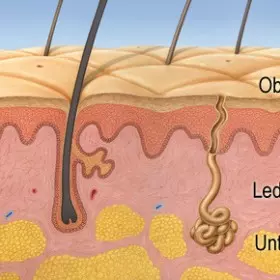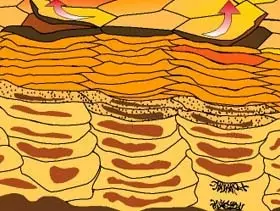BEAUTYCLINIC St. Gallen
9000 St. Gallen
BEAUTYCLINIC Zurich
8004 Zurich
BEAUTYCLINIC Winterthur
8400 Winterthur
BEAUTYCLINIC Engadin
7513 Silvaplana
BEAUTYCLINIC Chur
7000 Chur

- Body
- Face
- Skin
- Birthmark Removal
- Prices
The skin is the largest human organ. It is a sensitive, highly complex structure consisting of different layers: The epidermis, the corium and the subcutis.

The skin consists of approx. 65% water, 13% fat, the rest: protein and minerals.

The skin is the largest human organ. It is a sensitive, highly complex structure consisting of different layers: the epidermis, the corium and the subcutis.

The epidermis is only about 0.1 millimeters thick on average. The surface of the skin is covered with a thin layer of water and fat, known as the protective acid mantle. The outermost layer consists of keratinized, dead cells, which is why it is also called the stratum corneum.
Under the stratum corneum, there are various layers of corneum-forming cells that are constantly dividing and producing new ones. They migrate to the surface of the skin and replace dead cells there, renewing the entire epidermis within 27 days..
Nutrients are absorbed and metabolic waste products are disposed of via the basal membrane, the boundary layer to the dermis. The pigment cells, which produce the brown pigment melanin for the body's own sun protection, and the immune system's defense cells are also found here.

The dermis consists of two layers – a thin upper layer of loose connective tissue and a thicker lower layer of strong connective tissue fibers with collagen and elastin. They run like a network in horizontal bundles and ensure the firmness and elasticity of the skin.
The dermis contains blood vessels and nerve fibers with receptors for heat, cold and touch as well as lymph vessels which, as part of the lymphatic system, transport pathogens and harmful and foreign substances out of the tissue.
The subcutis consists mainly of fatty tissue, which is divided into individual fat lobules by connective tissue cords. When the connective tissue becomes slack, these become visible as cellulite dimples. The fat cells serve as protection against the cold and as an energy store. The larger blood vessels, nerve fibers, hair roots and sebaceous and sweat glands are also found here.
Like all organs, the skin is also affected by the ageing process. The signs of ageing begin in the late twenties/early thirties. Fine lines begin to form between the nose and mouth, around the eyes and on the forehead – the first wrinkles appear.
This is caused by external influences, but also by lifestyle and facial expressions. The first expression lines appear as a result of constantly repeated facial movements: smile lines, forehead wrinkles, crow's feet. The cause is a loss of elasticity, because the dermis produces fewer and fewer collagen and elastin fibers. This leads to a weakening of the connective tissue and sagging of the skin. This causes wrinkles to form, which remain visible as the ageing process progresses, even on a relaxed face.
The skin's ability to constantly renew itself decreases with age. On average, old skin takes twice as long, i.e. up to eight weeks, to renew itself. This is why wounds heal more slowly in older people. As a result of the declining function of the sebaceous and sweat glands, the natural protective acid mantle changes. The skin becomes drier and thinner because it can no longer retain sufficient moisture and oil.
The ageing process brings with it a range of unpleasant symptoms: dry skin, wrinkles, skin spots, sagging cheeks and many others. Ageing is based on a natural, genetically determined change in the body, in which hormonal changes play a central role. However, the speed and intensity with which skin ageing progresses depends largely on external factors, but also on lifestyle (stress, little sleep, unhealthy diet, etc.).
External circumstances as well as individual lifestyles damage the skin.
UV-A, UV-B, but also infrared radiation damage the skin on the surface and in depth. Light leads to the breakdown and cross-linking of collagen and elastin. In youth, these fibers are finely branched, with each sunbath they become thicker and shorter, the skin becomes less elastic.
A lack of sleep means that the skin's regeneration phase is too short, which also shortens the release of hormones. Repair mechanisms can no longer work effectively. The growth hormone produced at night (especially after 11 p.m.) activates cell renewal, but its effect is particularly efficient during sleep. At night, the production of new collagen also runs at full speed. Constant stress consumes more nutrients in the body, so that the skin lacks the most important organic substances for its regeneration. It looks pale, loses elasticity and water and forms wrinkles.
Toxic substances (including passive smoking) lead to the mass production of harmful free radicals, which destroy elastic fibers and slow down cell division. Nicotine is a vitamin C killer, so the vitamin for collagen formation is missing. The skin loses moisture and the complexion looks sallow. The cause is a lack of blood circulation in the blood vessels caused by nicotine.
Cold, wind, heat, air-conditioned air, electric light and mechanical stimuli such as shaving can lead to irritation and dryness of the skin, which impairs its immune protection.
Oxygen from outside gives a fresh complexion because cell renewal is activated. Indoor air is often too dry, the skin suffers and becomes pale.
Of course, genetics also determine the ageing process and appearance. Depending on the constitution, there are faces that look much younger than their age would suggest and people who appear much older.
As a general rule, the worse the genes, the more damaging skin influences should be avoided.
You can consciously protect your skin from potential damage with targeted measures.
Sunlight ages the skin prematurely and causes wrinkles. It is therefore important never to go out in the blazing sun unprotected. Clothing, headgear and a cream with a sufficient sun protection factor (60-100) help to prevent damage to the skin.
Without fluids, the skin loses its elasticity, which is why it is important to drink at least 2 liters every day. Every day, the skin alone releases large quantities of water via 2 million small sweat glands. Up to 5 liters of water can evaporate during physical exertion.
Fish, pulses, low-fat milk, fruit and vegetables are important to provide the skin with sufficient vitamins and trace elements. Vitamins C and E, plant pigments from tomatoes and phytohormones from soy help to protect the skin and regenerate it against antioxidants. A vitamin B6 deficiency leads to impaired maturation of the connective tissue, while the skin needs beta-carotene to grow. Vitamin B2 is important for the formation of enzymes in the skin and mucous membranes and prevents cracks in the corners of the mouth and lips.
Skin care should be started early, preferably from adolescence (age of majority). Moisturizing creams with a sun protection factor (at least 10) as daily cosmetics are necessary to prevent skin damage. From the age of 35, skin care products should contain vitamin C, E or co-enzyme Q10 as well as retinol . This protects the cells from ageing and promotes their renewal. Treatments with fruit acids (peeling) reduce wrinkles and spots and refresh the skin. This effect is also achieved by other methods of rejuvenation such as laser, microdermabrasion, peeling, Hydrafacial etc.
We understand that aesthetic treatment needs to be carefully considered. We are therefore happy to take the time to answer all your questions during a free, no-obligation initial consultation. Arrange your consultation appointment today at one of our BEAUTYCLINICs.
If you would like a brief online preliminary clarification before your consultation, you can also contact us by e-mail.
No matter which way you want to reach us - we look forward to hearing/reading from you!